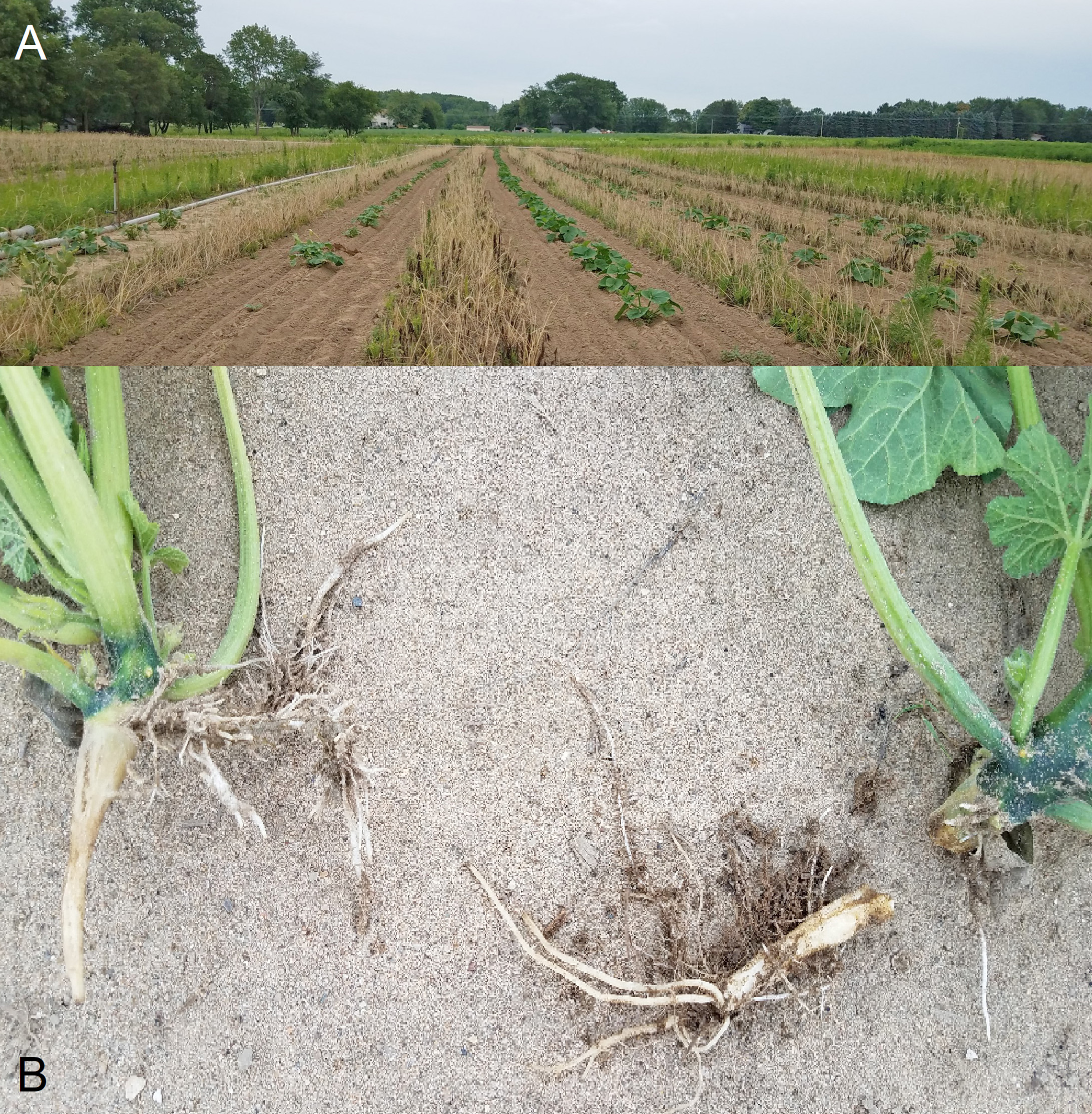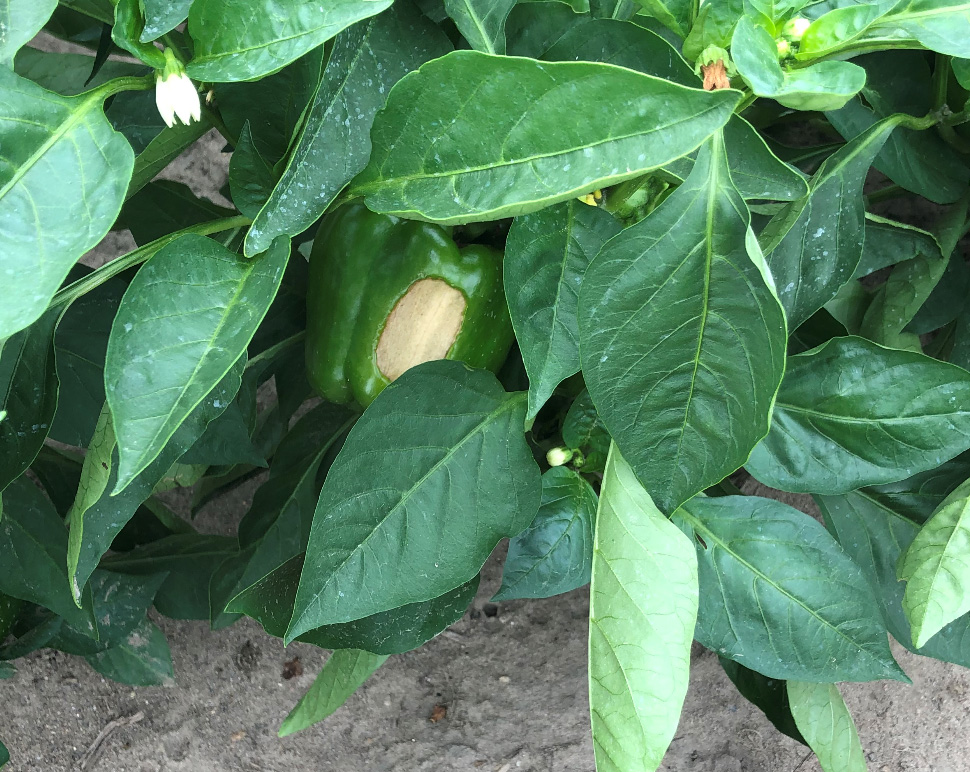Southeast Michigan vegetable update – July 22, 2020
High dewpoints and overcast skies promote disease development.

Weather
Today’s incoming weather front will move through with some scattered, localized showers. Like last week, warm, humid air will follow this weekend into early next week. Dewpoints will be high, again providing windows for disease development. Models are suggesting we will close out July with warmer than normal temperatures and normal to above normal precipitation totals. The long lead outlook is suggesting we will be warmer than normal through August, September and October.
The table below shows rainfall totals for the Michigan State University Enviroweather stations in southeast Michigan, as well as degree-days calculated using the Baskerville-Emin Method. Degree-day average for Commerce and Hudson is over five years, while Deerfield is over four years. Rainfall is in inches. For a refresher on degree-days and how to get this information in your area, see “Accessing growing degree days with Enviro-weather” from MSU Extension.
|
Rainfall and degree day totals as of July 22 |
||||
|---|---|---|---|---|
|
Station |
Degree days (base 42) |
Degree days (base 50) |
5-year degree day average (base 50) |
Rainfall since April 1 |
|
Commerce |
2156 |
1421 |
1379.3 |
10.17 (+0.71) |
|
Deerfield |
2340 |
1564 |
1602.3 |
9.58 (+0.44) |
|
Hudson |
2168 |
1428 |
1467.7 |
11.86 (+1.14) |
General note
While we haven’t had much rain, we’ve had the humidity and high dewpoints that favor the development of a wide variety of plant disease. Be vigilant in scouting and spraying—just because we haven’t had rain doesn’t mean we haven’t had the moisture plant diseases need to get established and spread.
Crop reports
Cucurbit crops
For cucmber and melon growers, the high humidity and overcast mornings mean downy mildew pressure remains high. A-team products for 2020 include Orondis Opti, Ranman tank mixed with Bravo and Zampro tank mixed with Bravo. Adhere to a seven-day spray interval. A consistent program will be especially important if the crop has a long way to go, as downy mildew can infect young plants. There are no reports on the clade that infects pumpkins and hard squash anywhere nearby.
Have pumpkins or winter squash that are wilting? While drooping leaves during the heat of the day is par for course, if plants have not recovered the next morning, they warrant a closer look. If you have plants that are consistently wilted, here are some helpful diagnostic questions to ask.
- What’s the distribution? Are the plants clustered in the same area or randomly distrubuted throughout the field?
- How to do the crowns and roots look?
- Solid and white, or mushy and brown? Underdevloped or fully developed?
- If you cut a crosssection of the crown, what is the coloration and texture? Is there a caterpillar in there?
If distrubution is clustered, especially if the plants are in a low spot and the entire plant is melting down, Phytophthora is a strong possibility. I recommend getting a plant sample to the MSU Plant & Pest Diagnostics lab.
If the distribution is random and the roots are firm and white but stunted, herbicide injury could be at play. Some key questions to ask are:
- What herbicides did I apply?
- When did I apply them?
- Did it rain afterwards? How much?
Preemergent herbicides need to be in certain depths in the soil profile to be effective against germinating weeds while not damaging crops. Heavy rainfall after application can move the product deep enough to damage plants. This damage can appear spotty because seeds may be planted at different depths and water can move differently through different parts of the field. Some things to look for include poor root development (but no signs of root rot), brittle crowns that break easily, plants that are small and unhealthy looking, and unusual leaf discoloration (for example, bleaching around the leaf margins).

Another potential cause if distrubtion is random is squash vine borer. If this is the culprit, you should see a hole with what looks like wet sawdust coming out. Cutting open the vine will reveal the feeding larvae. See “Squash vine borer biology and management.” I caught three squash vine borer moths in Washtenaw County this week, so they are still out and laying eggs.
Obviously, there is a lot to think about here. If you want to walk through what you are seeing or if you want a second opinion, feel free to reach out to me and we can arrange a field visit.
Solanaceous crops
In peppers, the intensely sunny days is leading to some sunscald. Sunscald is easy to recognize soon after it occurs, but the longer the injured fruit is in the field, the more opportunistic mold and fungi move in and affect the already damaged tissues. What will start as a defined, smooth, tanned area will start to become mushy and multicolored as fungi move in.

The hot weather means blossom end rot is common in tomatoes and peppers. This physiological disorder is linked to calcium, but just because you are seeing it doesn’t mean there is necessarily a deficiency. Calcium needs to be moved with water through the plant. During periods of hot weather and rapid growth, it can be hard for the plant to move calcium quickly enough to the rapidly developing fruit. Your soil test will let you know if your calcium levels are adequate. Beyond that, a steady supply of water, especially during periods of hot weather, is your best bet for preventing blossom end rot.
As tomatoes start to ripen, I start to get a lot of calls about late blight. We do not see late blight in Michigan every year. Typically, we see late blight move up from the southern U.S. over the course of the season. Right now, late blight hasn’t been reported anywhere further north than North Carolina. The signature symptom of late blight is firm, brown spots developing on unripe green fruit.
Some things I commonly get calls about that are mistaken for late blight include early blight, tomato leaf mold (hoop house tomatoes only) and fruit rots. Many fruit rots are related to fruit not being picked in a timely manner, especially if the fruit are in poorly ventilated areas (for example, low in the canopy of unstaked tomatoes) and there is moisture (either from rain or humidity). For heirloom tomatoes, the radial and concentric growth cracks that are characteristic of heirlooms can become infected by opportunistic fungi. During periods of high humidity/moisture, prompt harvest and storage somewhere dry will hopefully prevent the cracks from becoming infected.
Tomato hornworm is out and feeding in tomatoes and peppers. The size of the caterpillars makes this pest seem more threatening than it often is. Hornworms are a robust defoliator that also feeds on fruit. If you see a heavily defoliated plant, take a look underneath. Tomato hornworms are messy, and the ground underneath the plant should have a large amount of grenade-shaped poop. Their size and level of feeding might make you think you need to load up the sprayer right way, but hornworms don’t typically cause economic loss.
According to “Vegetable insect management” by R. Foster and B. Flood, 2005, targeted hornworm treatment is only warranted if an average of one caterpillar is found every two plants. I have not seen this level of pressure. For organic producers, B.t. is a good tool but has to be used when caterpillars are small. The caterpillars I’ve been seeing are large and nearing pupation, meaning that B.t. won’t be too effective, and the hornworm has already done a majority of its damage. For more information on both organic and conventional controls, see the Midwest Vegetable Production Guide.
Sweet corn
Sweet corn pest pressure continues to be low. Corn earworm pressure is low (about one moth caught in my Monroe and Lenawee County traps per night). Silking field corn will further dilute pressure. Western bean cutworm is starting to fly, but numbers are low in local traps. The second generation of European corn borer adults are flying and laying eggs, according to the region’s Enviroweather stations.
Something to keep an eye out for in both sweet and field corn is tar spot. This is a new corn disease in Michigan that has been detected in our area in the past. For more information, see “Tar spot in the spotlight.”
Reach out
Please contact me at schuhmar@msu.edu or 517-264-5309 with questions, concerns or to schedule a field visit. I have the ability to visit fields on a limited basis.
Great Lakes Vegetable Producer’s Network
The Great Lakes Vegetable Producer's Network is a live weekly roundtable discussion during the growing-season for commercial vegetable producers in the Great Lakes and Midwest region. It is broadcast live via Zoom at 12:30 ET/11:30 CT every Wednesday from the first week of May to the first week of September. Listen live or later. If you have a pressing vegetable production issue that you would like discussed, simply email it, along with your phone number, to greatlakesvegwg@gmail.com.
Next week will focus on worms in sweet corn.



 Print
Print Email
Email

